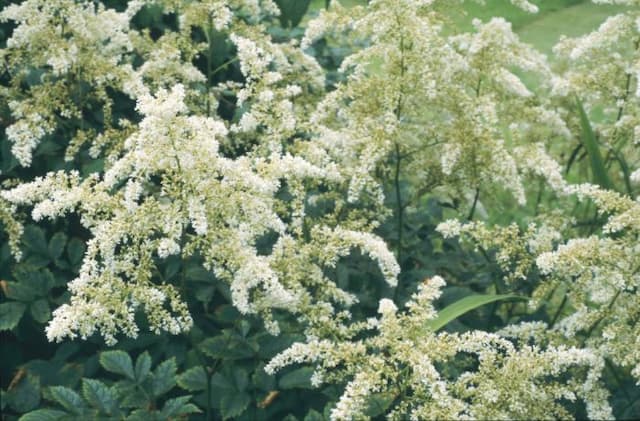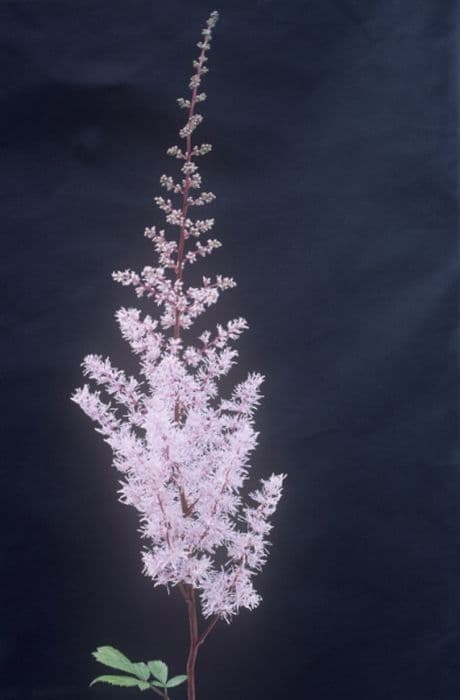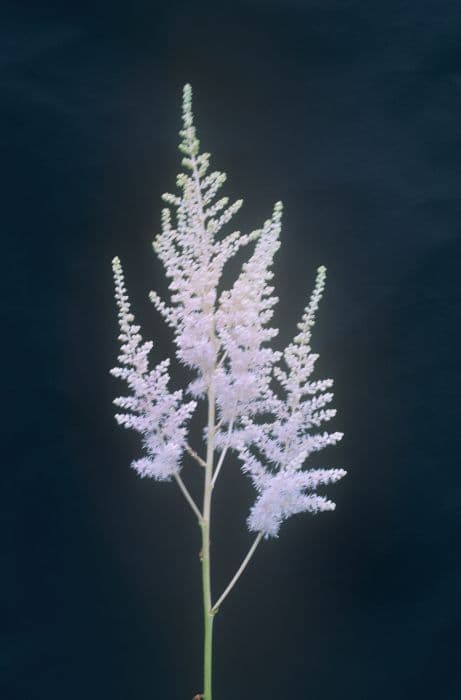False Spirea Astilbe 'Deutschland' (japonica hybrid)

ABOUT
Astilbe 'Deutschland' is a perennial plant known for its lush, fern-like, deep green foliage that provides an attractive backdrop to its striking white plume-shaped flowers. These flowers cluster together on tall, erect stems, creating fluffy, feathery spires that stand above the leaves, giving a soft and elegant appearance. The blooms offer a subtle but delightful fragrance that can attract pollinators like butterflies to the garden. They typically appear in late spring to early summer, depending on the climate. The leaves of Astilbe 'Deutschland' are compound, with multiple leaflets arranged in a symmetrical pattern, lending a fine, textured look to the foliage. These leaflets have serrated edges, and the veins are often prominently etched into the surface, which can be especially noticeable when water droplets rest upon them, glistening in the sunlight. In terms of color palette, the pure white of the flowers contrasts beautifully with the rich greens of the foliage. This contrast makes Astilbe 'Deutschland' a popular choice for shaded garden areas where it can brighten up darker spaces. The plant overall creates an aura of softness and elegance in the landscape, complementing both modern and traditional garden designs. It can be used effectively in borders, as a focal point in a shade garden, or as a part of a mass planting for a dramatic visual effect.
About this plant
 Names
NamesFamily
Saxifragaceae.
Synonyms
False Spirea, False Goat's Beard, Star of Persia.
Common names
Astilbe japonica 'Deutschland'.
 Toxicity
ToxicityTo humans
Astilbe, commonly known as False Goat's Beard, is not known to be toxic to humans. Therefore, there are generally no symptoms of poisoning associated with ingesting this plant.
To pets
False Goat's Beard is not considered toxic to pets either. Ingesting parts of this plant should not lead to any significant symptoms of poisoning in pets. However, as with any non-food plant, ingestion might cause mild gastrointestinal upset due to the novelty of the item in the animal's diet.
 Characteristics
CharacteristicsLife cycle
Perennials
Foliage type
Deciduous
Color of leaves
Green
Flower color
White
Height
2 feet (60 cm)
Spread
1.5 feet (45 cm)
Plant type
Herb
Hardiness zones
4
Native area
Asia
Benefits
 General Benefits
General Benefits- Attracts Pollinators: Astilbe 'Deutschland' is known to attract bees and butterflies, which help pollinate other plants in the garden.
- Low Maintenance: This plant is relatively easy to care for and does not require frequent watering or pruning.
- Shade Tolerant: It thrives in partial to full shade, making it an ideal choice for shaded or woodland gardens.
- Seasonal Interest: Provides beautiful, showy plumes of white flowers in the spring and summer, adding aesthetic value to any garden.
- Deer Resistant: Generally resistant to deer, which helps to prevent damage to the garden from grazing animals.
- Drought Tolerant: Once established, Astilbe 'Deutschland' is relatively drought tolerant, requiring less frequent watering.
- Works for Borders: The compact and clumping nature of this plant makes it great for garden borders or as a ground cover.
- Color Variation: Offers a variation of color with its attractive deep green foliage, which contrasts well with the vivid white flowers.
- Soil Adaptability: Can adapt to a wide range of soil conditions as long as the soil is well-draining.
- Winter Interest: Foliage and seed heads can provide texture and interest in the winter garden.
 Medical Properties
Medical PropertiesThis plant is not used for medical purposes.
 Air-purifying Qualities
Air-purifying QualitiesThis plant is not specifically known for air purifying qualities.
 Other Uses
Other Uses- Creative Arts: Astilbe can be used by artists as a natural inspiration for paintings, illustrations, and fabric patterns due to its unique feathery plumes and foliage structure.
- Dye Production: The leaves and flowers of Astilbe 'Deutschland' may be used to produce natural dyes for textiles, offering subtle shades depending on the mordant used.
- Photography Enhancements: Due to its striking appearance, Astilbe can be utilized as a subject or backdrop in macro photography, capturing the details of its intricate blooms and textures.
- Water Feature Companions: When planted around ponds or water features, Astilbe adds a soft, feathery texture and a pop of color, enhancing the aesthetic of water gardens.
- Potpourri Ingredients: Dried Astilbe flowers can be included in homemade potpourri mixes for a gentle, natural fragrance and varied texture in a mix with other dried plants.
- Educational Tools: Astilbe can serve as a plant model to teach about pollination and the lifecycle of perennial plants in educational settings.
- Floral Crafts: Astilbe’s flower spikes can be dried and used in craft projects, such as making flower crowns or adding an element to wreaths and other dried floral arrangements.
- Erosion Control: Astilbe can be used on slopes or areas where erosion is a concern, as its root system helps to hold the soil in place.
- Garden Themed Artwork: Pressed Astilbe flowers can be incorporated into handcrafted paper or used in botanical prints, bookmarks, and greeting cards.
- Culinary Garnish: While not commonly consumed, the flowers of Astilbe can be used as a decorative, non-toxic garnish for culinary presentations.
Interesting Facts
 Feng Shui
Feng ShuiThe Astilbe is not used in Feng Shui practice.
 Zodiac Sign Compitability
Zodiac Sign CompitabilityThe Astilbe is not used in astrology practice.
 Plant Symbolism
Plant Symbolism- Patience: Astilbe takes its time to bloom and requires a watchful eye to keep it healthy, symbolizing the virtue of patience in nurturing and personal growth.
- Enduring Love: With its perennial nature, Astilbe is often associated with long-lasting love and commitment.
- I'll Still Be Waiting: The name "Astilbe" sounds like "I'll still be," which can be interpreted as a symbol of waiting for someone you love.
 Water
WaterFalse Spirea, including Astilbe 'Deutschland', should be watered deeply about once a week, ensuring the soil remains moist but not waterlogged. During hot and dry periods, water twice a week, providing 1 to 2 gallons per plant depending on the size and weather conditions. It's best to water the plants in the morning to allow any excess moisture on the foliage to evaporate throughout the day. Avoid overhead watering to prevent leaf diseases; instead, water at the base of the plant.
 Light
LightFalse Spirea thrives best in partial to full shade. The ideal spot for Astilbe 'Deutschland' is in an area that receives morning light and is protected from the harsh afternoon sun, which can scorch its delicate leaves. Dappled sunlight under a canopy of trees or on the north side of a building is often perfect, ensuring it gets enough light without being exposed to intense sun.
 Temperature
TemperatureAstilbe 'Deutschland', or False Spirea, prefers cool climates and can survive in temperatures as low as -20 to -30 degrees Fahrenheit during dormancy in winter. It grows best in temperatures between 60 and 75 degrees Fahrenheit. It is important to protect the plant from extreme heat, especially temperatures over 80 degrees Fahrenheit, to prevent stress and wilting.
 Pruning
PruningPruning False Spirea is essential for maintaining its shape and encouraging vibrant blooms. After flowering, trim the spent flower stalks to promote a tidy growth habit. In early spring, prune any dead or damaged wood and thin out the plant if necessary. It's not required to prune Astilbe 'Deutschland' regularly, but doing so after flowering and in early spring can enhance its appearance and vigor.
 Cleaning
CleaningAs needed
 Soil
SoilFalse Spirea thrives in a soil mix that is rich in organic matter with good drainage. A mixture of garden soil, compost, and peat moss or leaf mold is ideal. For optimal growth, maintain a soil pH of 6.0 to 7.0, as this plant prefers slightly acidic to neutral conditions.
 Repotting
RepottingFalse Spirea should be repotted every 2-3 years. The best time to repot is in the early spring before the growing season starts, as this is when the plant is in its dormant phase and can recover more easily from transplant shock.
 Humidity & Misting
Humidity & MistingFalse Spirea prefers a high humidity environment, thriving best with humidity levels around 60-80%. Providing a humid microclimate can help mimic its natural, moisture-rich habitat.
 Suitable locations
Suitable locationsIndoor
Place False Spirea in well-draining soil, partial shade, and ensure high humidity.
Outdoor
Plant in moist soil; partial shade; protect from hot afternoon sun.
Hardiness zone
4-8 USDA
 Life cycle
Life cycleThe Astilbe 'Deutschland', commonly known as False Spirea, begins its life cycle as a dormant rhizome that is typically planted in the spring. This perennial plant emerges from the rhizome, producing finely textured, fern-like foliage. As it matures, the False Spirea develops upright plumes of fluffy, white flowers that bloom in early to midsummer, attracting pollinators. After flowering, the plant sets seeds that can disperse to propagate new plants, though propagation is more commonly done by dividing rhizomes. In the fall, the foliage may turn a yellowish or brownish hue before the plant goes dormant for the winter. Each year, the rhizome grows larger, causing the plant to increase in clump size and produce more flowering stalks.
 Propogation
PropogationPropogation time
Early Spring
Astilbe 'Deutschland', commonly known as False Spirea, is best propagated by division. The ideal time to divide and propagate these plants is in the spring or early fall, when the plant is not in active bloom. To propagate by division, carefully dig up the entire clump of Astilbe and gently separate it into smaller segments, ensuring that each division has at least three to five shoots or eyes and a portion of the root system. Replant these segments immediately at the same soil depth they were previously growing, spacing them about 18 to 24 inches (approximately 45 to 60 centimeters) apart to give them ample room to grow. Water the newly planted divisions thoroughly to help establish them. This method of division helps to rejuvenate older plants while also providing new plants to expand your garden or share with fellow gardeners.









